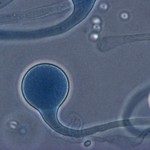Link to Pubmed [PMID] – 27744309
Link to DOI – 10.1093/mmy/myw107
Med. Mycol. 2017 Jul; 55(5): 476-484
Tinea capitis (TC) is a highly contagious fungal infection of the scalp due to dermatophytes in children. To obtain information on the epidemiology of TC in the urban area of Paris, we analysed the microbiological results of 3090 patients seen with suspected TC from October 2010 to September 2015 at Saint Louis hospital, Paris, France. A peak of TC was observed in 3-6 year-old children, followed by a progressive decrease until 16 years of age. Of the 1311 positive cultures, 95% (1246) yielded one of the three anthropophilic species [Trichophyton tonsurans (33.5%), Trichophyton soudanense (38.3%), or Microsporum audouinii (28.2%)]. When considering one TC case per family, we observed a significant increase of T. tonsurans (P = .018) during these 5 years. The increase was more pronounced (P = .0047) in patients of West-African descent (n = 666), and was at the expense of M. audouinii and T. soudanense. On the other hand, the Caribbean patients (n = 85) remained predominantly (72.9%) infected by T. tonsurans. Our results show a better virulence of T. tonsurans over other species as already reported. Since T. tonsurans has not been reported in Africa, the infection of patients of West-African descent probably took place in the Paris area by exchanges with Caribbean patients. This increase of TC due to T. tonsurans was observed in the context of griseofulvin being the only licensed paediatric treatment for TC in France, which should deserve reappraisal because terbinafine may be more efficacious.



